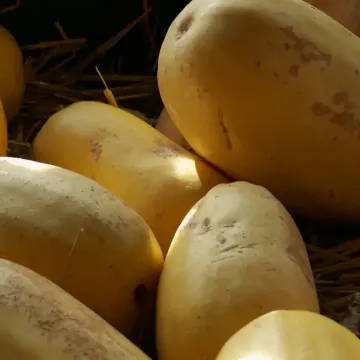Spaghetti squash is a popular winter squash variety known for its unique, stringy flesh that resembles spaghetti noodles when cooked. This versatile vegetable is a favorite among home gardeners for its ease of growing, long storage life, and numerous culinary uses. Here's a guide to growing spaghetti squash in your home garden.
Introduction to Spaghetti Squash
Spaghetti squash (Cucurbita pepo) is a type of winter squash that belongs to the Cucurbitaceae family, which includes pumpkins, zucchini, and cucumbers. Unlike summer squashes, spaghetti squash has a hard rind and can be stored for several months after harvest. This yellow, oval-shaped squash is nutrient-rich and provides a low-calorie alternative to pasta.
Health Benefits of Spaghetti Squash
Spaghetti squash is a nutrient-dense food, providing a variety of vitamins and minerals. It is an excellent source of vitamin A, vitamin C, and several B vitamins. It is also rich in fiber, which supports digestive health. With its low-calorie content and complex carbohydrates, spaghetti squash is an excellent option for those looking to manage their weight or blood sugar levels.
Planting Spaghetti Squash
Site Selection
Spaghetti squash plants thrive in full sun, needing at least 6-8 hours of direct sunlight daily. They prefer well-drained soil rich in organic matter. Before planting, amend your garden soil with compost to provide the necessary nutrients for healthy growth.
Planting Time
Spaghetti squash is a warm-season vegetable, so it should be planted after the last frost date in your area when the soil has warmed to at least 70°F (21°C). You can start seeds indoors 2-4 weeks before the last frost, or sow them directly into the garden once the danger of frost has passed.
Spacing and Depth
Spaghetti squash plants are vigorous growers that need plenty of space. If direct sowing, plant seeds about 1 inch deep in hills spaced 4-5 feet apart. If using transplants, plant them at the same spacing. For vertical gardening, use a strong trellis to support the vines, which can help save space in smaller gardens.
Growing Tips for Spaghetti Squash
Watering
Consistent watering is key to healthy spaghetti squash plants. Keep the soil evenly moist but not waterlogged. Water at the base of the plants to avoid wetting the leaves, which can lead to fungal diseases. Fertilizing
Spaghetti squash benefits from regular feeding. Apply a balanced fertilizer, such as a 10-10-10 formulation, when the plants begin to vine. You can also side-dress with compost or well-rotted manure to keep the soil fertile throughout the growing season.
Mulching
Mulch around the base of your plants to retain moisture, suppress weeds, and maintain a consistent soil temperature. Organic mulches such as straw, leaves, or compost work well.
Pest and Disease Control
Spaghetti squash plants are susceptible to common garden pests like squash bugs, cucumber beetles, and vine borers. Regularly inspect your plants for signs of infestation and consider using row covers early in the season to protect young plants. For disease prevention, practice crop rotation, and avoid overhead watering.
Harvesting Spaghetti Squash
Spaghetti squash is ready for harvest when the rind turns a deep yellow and is hard enough that it cannot be easily punctured with your fingernail. Typically, this occurs 90-100 days after planting. Cut the squash from the vine, leaving a few inches of stem attached to extend storage life.
Storing Spaghetti Squash
After harvesting, cure the spaghetti squash by placing it in a warm, dry place for 7-10 days. Once cured, store it in a cool, dry location with good air circulation. Properly stored spaghetti squash can last up to several months.
Culinary Uses of Spaghetti Squash
Spaghetti squash is a versatile ingredient that can be used in various dishes. After cooking, the flesh can be scraped out with a fork to create "noodles" that are perfect for replacing pasta in dishes like spaghetti with marinara sauce, stir-fries, or casseroles. It can also be roasted, stuffed, or used as a side dish seasoned with herbs and olive oil.
Growing spaghetti squash in the home garden is a rewarding endeavor that offers a delicious, healthy alternative to traditional pasta. With proper care, these hardy plants will provide an abundant harvest that can be enjoyed throughout the fall and winter months. Whether you're a seasoned gardener or new to growing squash, spaghetti squash is a great addition to any garden.

